
Boreolithothamnion phymatodeum
Knobby Coralline Crust
28 May 2025
Big Beach, Vancouver Island, B.C., Canada.
Tide: - 0.3 foot low at 08:16am PDT (measured at Ucluelet Tidal Station)
Weather: Mostly clear, wind variable 5 - 10 km/hour, sea light chop, moderate westerly swell, humidity 81%, 15 ˚C.
Moon: Waxing Crescent, (4.1%, 2 days); Next phase, First Quarter, 2 June 2025 at 8:40pm PDT; Previous phase, New Moon, 26 May 2025 at 8:02pm PDT.
and:
26 June 2025
Fishboat Bay, Juan de Fuca Strait, B.C., Canada
Weather: Overcast, wind variable 5 – 10 km/hour, sea rippled, no swell, humidity 88%, 13 ˚C.
Tide: -0.7 foot low at 9:29am PDT (measured at Sheringham Point Tidal Station)
Moon: Waxing Crescent (2.5%, 1 day); Next Phase, First Quarter, 2 July 2025 at 12:30 pm PDT; Previous Phase, New Moon, 25 June 2025 at 3:31 am PDT.
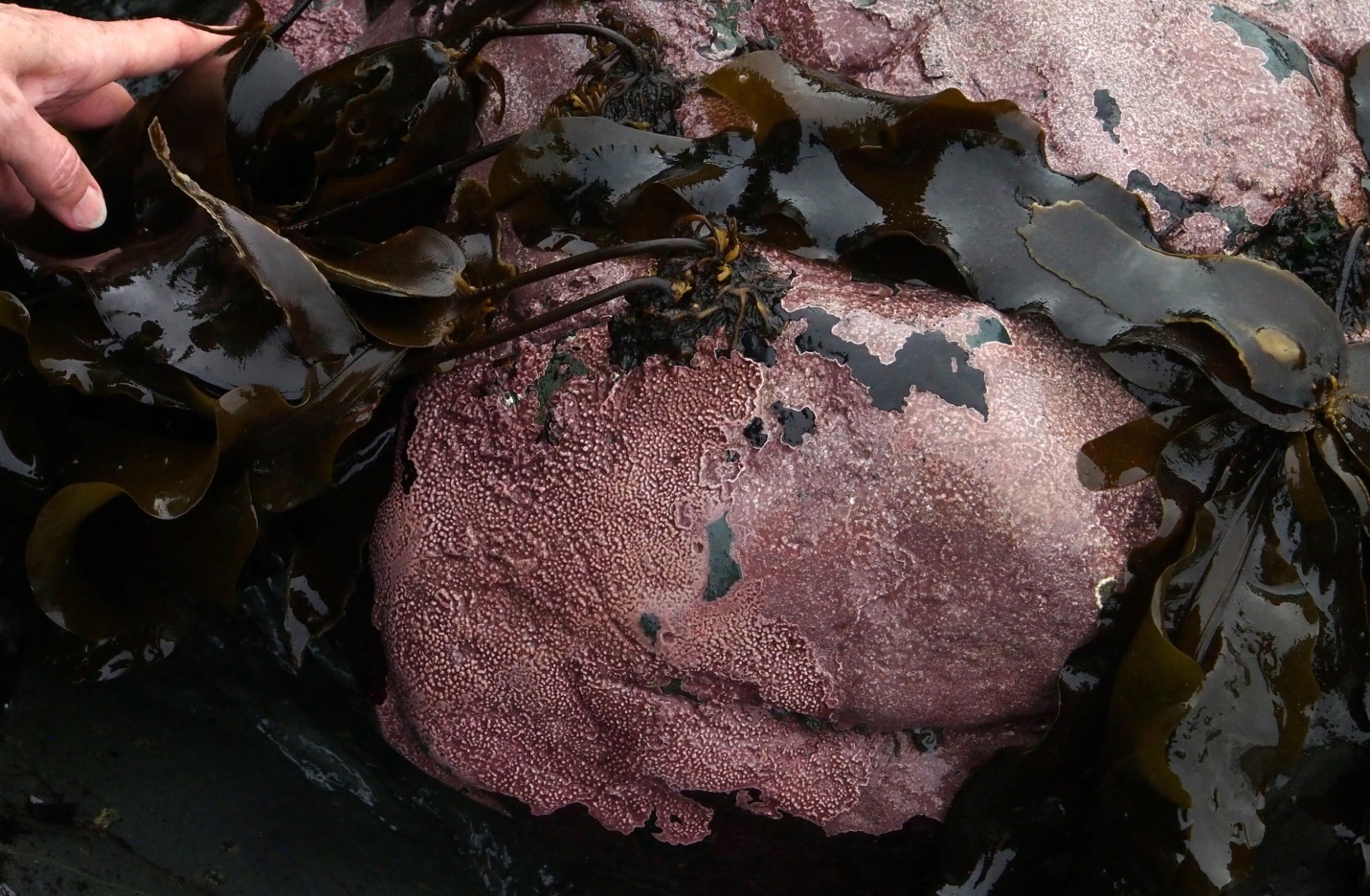
Figure 1: With a calm sea, a minus tide and a peek under some Alaria marginata kelp blades, a large patch of Boreolithothamnion phymatodeum is revealed. This pink colored coralline crust alga with its prominent excrescences lives on rock, stones, mollusc shells and some other algae species in the very low intertidal and subtidal regions. Fishboat Bay, Juan de Fuca Strait, B.C., Canada. June 26, 2025. Photo ID 27792 ©Seaweedwhisperings.com
Person 1:
There is an exceptionally pleasant feel to the touch. The bumps are smoothly polished.
The bumps don’t look as attractive as they feel to the touch. Look as though they might be pustules or filled with pus, but I know they are solid.
Upon contemplating the look of this seaweed, I wonder about its history. Alongside or beneath the current growth, there seemed to be faded, weathered versions from times past. What happened to you? Does anyone know?
The newer growth is determined to keep going, casting aside fears or memories of what happened in the past.
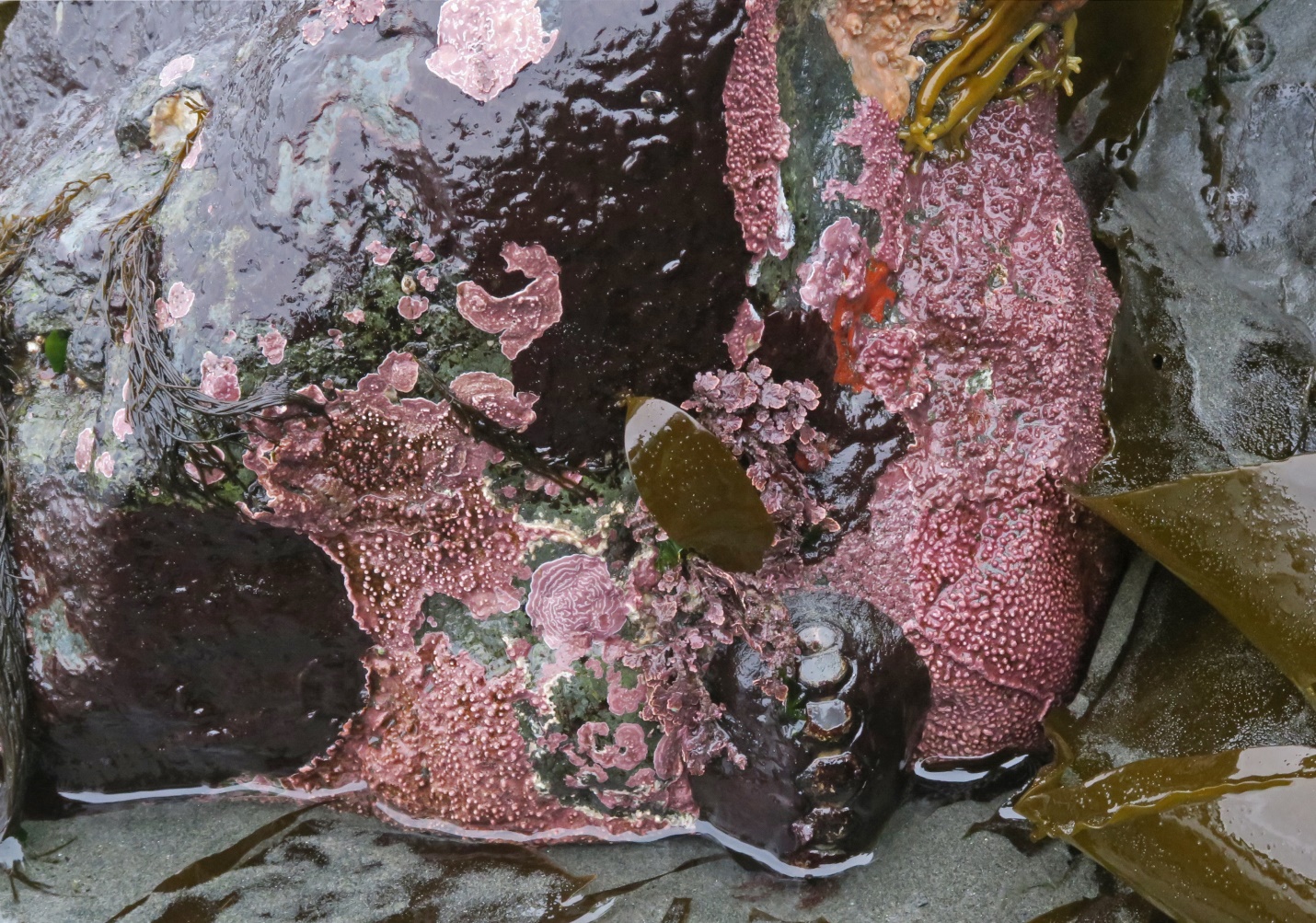
Figure 2: Boreolithothamnion phymatodeum is doing well here; several patches of this crust cover this boulder which is only accessible at minus tides. Some older patches have white lines indicating where limpets have previously grazed. A few articulated coralline seaweeds are also living here, along with the deep red petrocelis phase of a Mastocarpus species; the animal kingdom is represented by some bright red sponge and pale orange carpet sponge and two species of chitons (one of which is camouflaged nicely with the algae). Fishboat Bay, Juan de Fuca Strait, B.C., Canada. June 26, 2025. Photo ID 27793 ©Seaweedwhisperings.com
Person 2:
A pink colored calcareous crust that has a distinctive texture – large bumps irregularly but fairly closely spaced over its entire surface. It has quite the ‘topography’ compared to other marine algal crusts which tend to be far smoother.
This crust likes to grow in very low intertidal and shallow subtidal areas. In these places often the patches of Boreolithothamnion crust stand out simply because of their bright color, one that contrasts strongly with the natural shades and tones of bedrock and cobble.
While I found the bright color drew my attention, when I looked more closely at the large rounded bumps that cover this seaweed’s surface, I found it to be somehow less interesting than expected. I even felt the stirrings of disappointment. It was almost like the up and down, up and down, up and down of the bumpy ‘topography’ was very simple and too monotonous. This surface texture was surely formed for a purpose that suits Boreolithothamnion very well, but my first response was to find it tedious. This quickly dulled my interest.
When I ‘forced’ myself to explore further, I found that while this seaweed forms an overall bumpy surface, each bump is not really the same as its neighbor; they are irregular enough in shape and size to suggest that they were possibly hastily formed. There’s no artistry of design or pattern, but the bumps get made and it seems that there is no need for adjustment or revision; they are adequate just as they are.
So, this red alga first grabbed my attention with bright and cheerful coloration, and then lost my attention with its repetition of form. Many seaweeds have a repetition of form as part of their morphology so I asked myself, why does that factor in this species cause me to lose my interest? It didn’t take me long to see that this is because it also does not move! There’s no visible interaction when waves crash over its surface. It doesn’t dance with other algae nor twist any blades to catch the light this way or that way. It simply doesn’t budge. There is no perceptible movement whatsoever. Boreolithothamnion exists right now and right here, and plans to stay right here indefinitely.
These bumps, they now ‘prodded’ me to explore further. I saw them each as some comparatively large expression that was made at a certain point in time. Between these bumps, there is what I’ll call the ‘home base’ level. I felt that if I tried to understand what happened to create the bumps I would only get the rounded top surface representation and NOT what pushed the bump to appear in the first place. That propelling force, whatever it might have been, would be found only down at the home base level and that level, with this seaweed, is intentionally inaccessible.
The bump tops are also paler in color, very pale pink, almost white, compared to the base level which can be quite a rich and dark pink. It’s like the pigment for that area was not increased when the bump formed, and so the bump had to s-t-r-e-t-c-h its resources and make do with less intense coloration. It isn’t hard to think of these bumps as places where the seaweed was ‘stressed’ and that it simply burst upwards using whatever it had to work with at the time. This could imply little planning, and also short stamina, so there quickly will be a return to the base level.
But the bumps remain..., a history, yes a collection of stories..., about a life; they are almost like a scar that has hardened and marked a wound. I wonder if this seaweed perhaps doesn’t know how to resolve old wounds, or is only learning how. So for now they carry them along into the future, these stories marked in their flesh, and there is an acceptance that the stories will remain a part of them.
Looking at this seaweed the observer can be easily encouraged to only see the bumps and not look at the ‘valleys’ or the overall shape of the crust. Maybe this is also intentional – a way to divert scrutiny that gives them a type of protection.
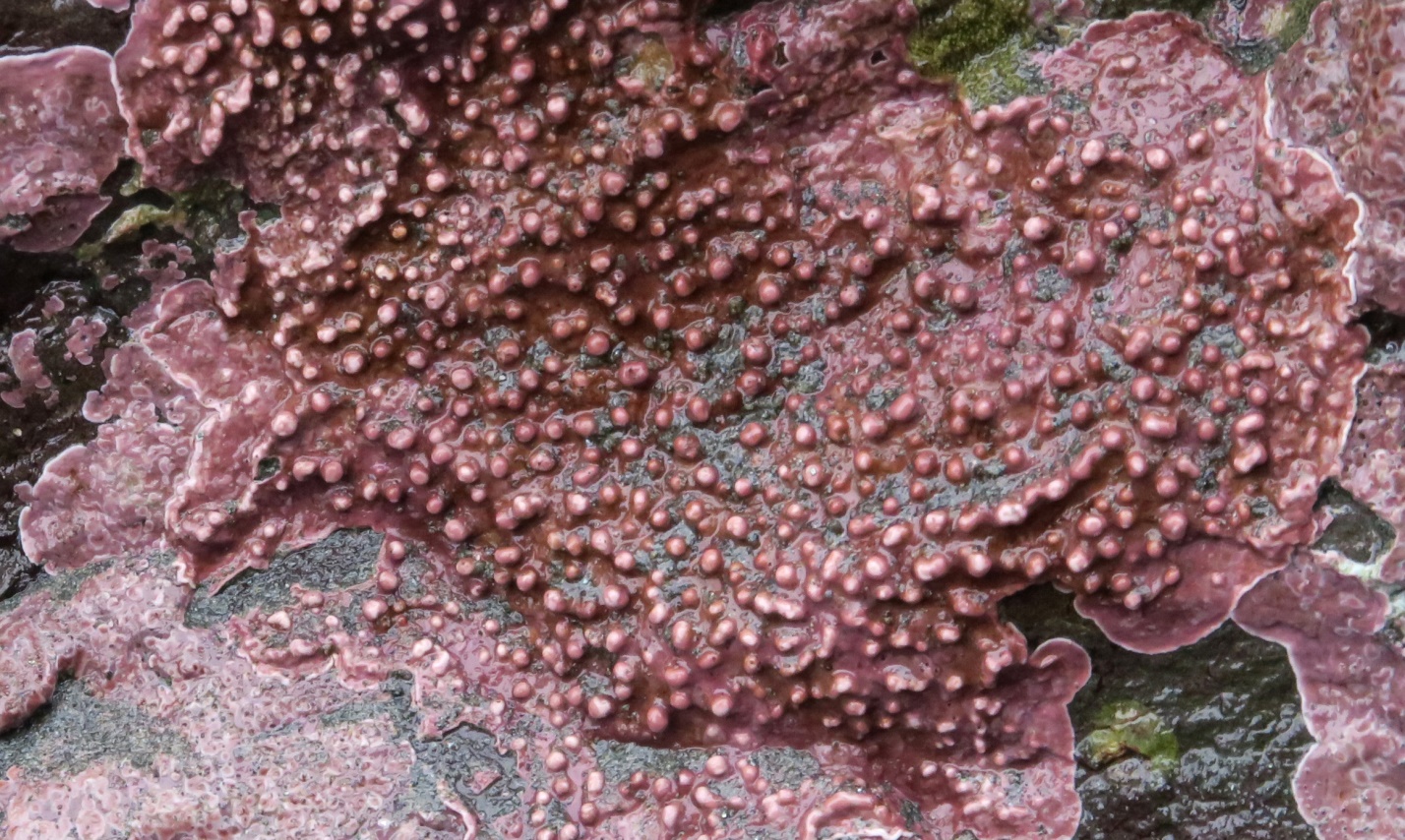
Figure 3: This zoomed in view shows the ‘bumps’ in detail and the ‘topography’ these excrescences create. Sand has collected in some of the ‘valleys’ while the ‘peaks’ stand above, paler in color and rounded smooth in shape. Fishboat Bay, Juan de Fuca Strait, B.C., Canada. June 26, 2025. Photo ID 27794 ©Seaweedwhisperings.com
Discussion:
This is a highly textured coralline crust alga. When we explored them, the bumps either made us lose interest or we found they were a way to divert our attention. Why is Boreolithothamnion phymatodeum so uncomfortable with being observed? We found two main reasons.
One is that’s just how they are; no rationale exists. It doesn’t really make sense in a logical way so might be closer to an intuitive way of being.
The other is a certainty in them that says, “Don’t tell me I’m not doing it the right way because this is how I’ve figured it out and I’m sticking with it”.
So, the inquiring observation we attempted to do, for them feels too much like scrutiny --- an inspection, or searching study, possibly at times even like an examination.
They do not wish to be the subject of scrutiny – that is clear. When you touch the seaweed it feels smooth, when you look at it, it is anything but. The contradiction is plain to see and any explanation for that contradiction is simply not on offer.
“Pretty in pink”..., it feels good to ‘be’ pink..., it was even noted that it felt just right to wear pink colored clothing (normally not a preference) – this is the feeling of Boreolithothamnion phymatodeum. When this concept became clear – feels good to be pink, Person 2 was out walking her usual neighborhood loop. As she held this thought in mind to add to her notes back at her desk, she smiled to see that while passing the cluster of Nootka roses (Rosa nutkana) along her route there was one lovely pink flower blooming today. Previous observations had led to the thought that these bushes had finished their flowering for this year as no blossoms had been seen on them for many days in succession, but on the day Person 2 was connected with this “pink” energy from our seaweed, one more flower graced the pathway as if to validate the concept. There are many shades of pink in nature but on the seashore it is the coralline algae that add this color to their environment.
Pink is a blend of red and white and it is interesting to consider that these crusts, which have calcium carbonate in their make-up (calcium carbonate is chalky white) these crusts are red seaweeds that have their ‘red’ toned down by chalk. The chalk is in their cells and the feeling and energy of pink is deeply a part of this species, too. And what are the feelings related to pink?
The ones we sense in this seaweed are:
A kind of vulnerability that comes with newness or young age;
A hesitancy in relating with others;
Taking genuine earthly pleasure in being attractive;
Having warmth, but also the warmth is limited, so this is not a full fire, but the ‘idea’ of a fire, or a fleeting fire.
In some of our observations and photographs, we have seen this crust, Boreolithothamnion phymatodeum, overgrowing other crusts. Figure 4 shows it doing so with Hildenbrandia. And Figure 5 shows it adjacent to two different articulated coralline algae whose basal crusts might actually be in the process of being overgrown by B. pymatodeum. Possibly this indicates that Boreolithothamnion is faster growing, faster relative to other crusts. Possibly this seaweed gets going without any consideration or hesitation about the suitability of the ‘surface’ they plan to occupy. They see some space and they take it. Others then may get encroached upon...., even smothered..., can only try to mitigate the damage resulting from this interloper’s actions. Once Boreolithothamnion phymatodeum moves in it rarely seems to move out again, so the neighbors have no choice but to accept the consequences. This feels rather brutish, uncivilized for sure; competition among the algal crusts seems to be a fact of life.
A quote from Tennyson came up --- “nature, red in tooth and claw...” This speaks to savage or merciless conflict or competition. Research about coralline crusts show there is much competition for space amongst species; they overtake open substrate, other fleshy seaweeds and even the surfaces of some marine animals. The kind of competition that Boreolithothamnion phymatodeum partakes of is merciless; there is a basic survival drive that is innate, and they don’t consider this aspect of their nature to be competitive – it is fundamental to life. Is this savage? It’s certainly untameable. So maybe this pink alga is not the red of prey blood as in the cycle of life and death seen with land animals, but it is totally a matter of life or no life that they find suitable space in which to grow.
“Prodded”..., this word came up with our interactions. Synonyms include “poke, jab, dig, nudge, elbow, butt, push...” All of these words are very physical and proactive. For a seaweed that doesn’t move much at all these kind of verbs feel like a good fit for Boreolithothamnion; it is in this way that this seaweed can use its ‘physicality’ to get its message across. It prods, pokes, makes a jab, and it does this first, before trying things like engaging in discussions or other forms of communication. It can go with the physical, not the verbal. Of course, those around them may not really respond in their best manner when physically prodded or elbowed or butted and their reaction may be part of what causes the ‘valleys’ in this seaweed. First B. phymatodeum prods, jabs and pushes and then very frequently they receive a negative response from those that they prodded; this discourages them and then they curb or restrain their prodding action. Do these experiences add up to any kind of new understanding for Boreolithothamnion? It feels as if the learning does happen but it is quite slow and also, as seen in the repetitions of the similar but irregularly shaped bumps, the lessons will continue to repeat for them, unvarying in any major way and patiently presented, for as long as is necessary.
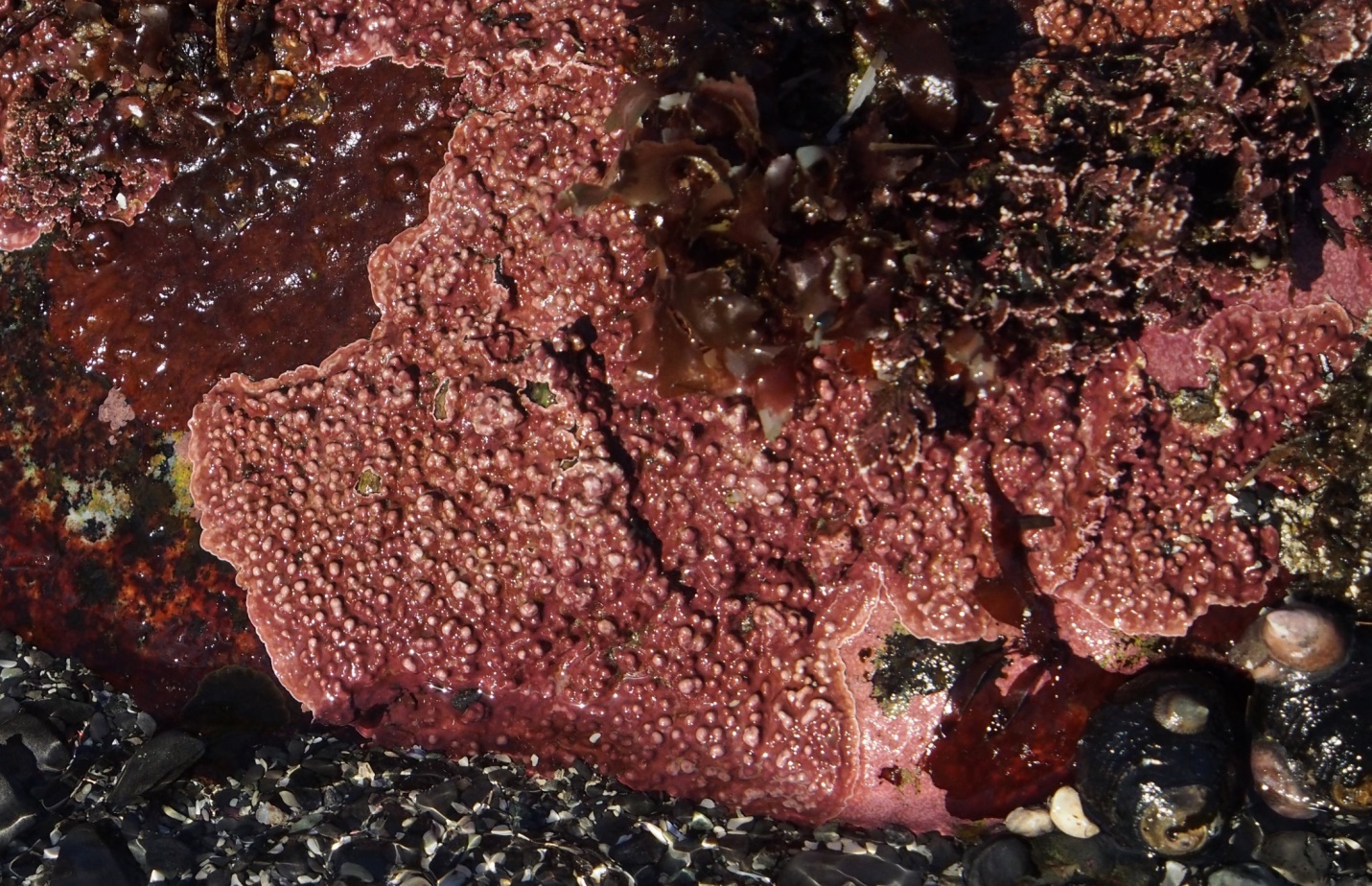
Figure 4: The low golden light of early morning makes this patch of Boreolithothamnion phymatodeum even more striking with its “feels good to be pink” nature. Big Beach, Vancouver Island, B.C., Canada. May 28, 2025. Photo ID 27795 ©Seaweedwhisperings.com
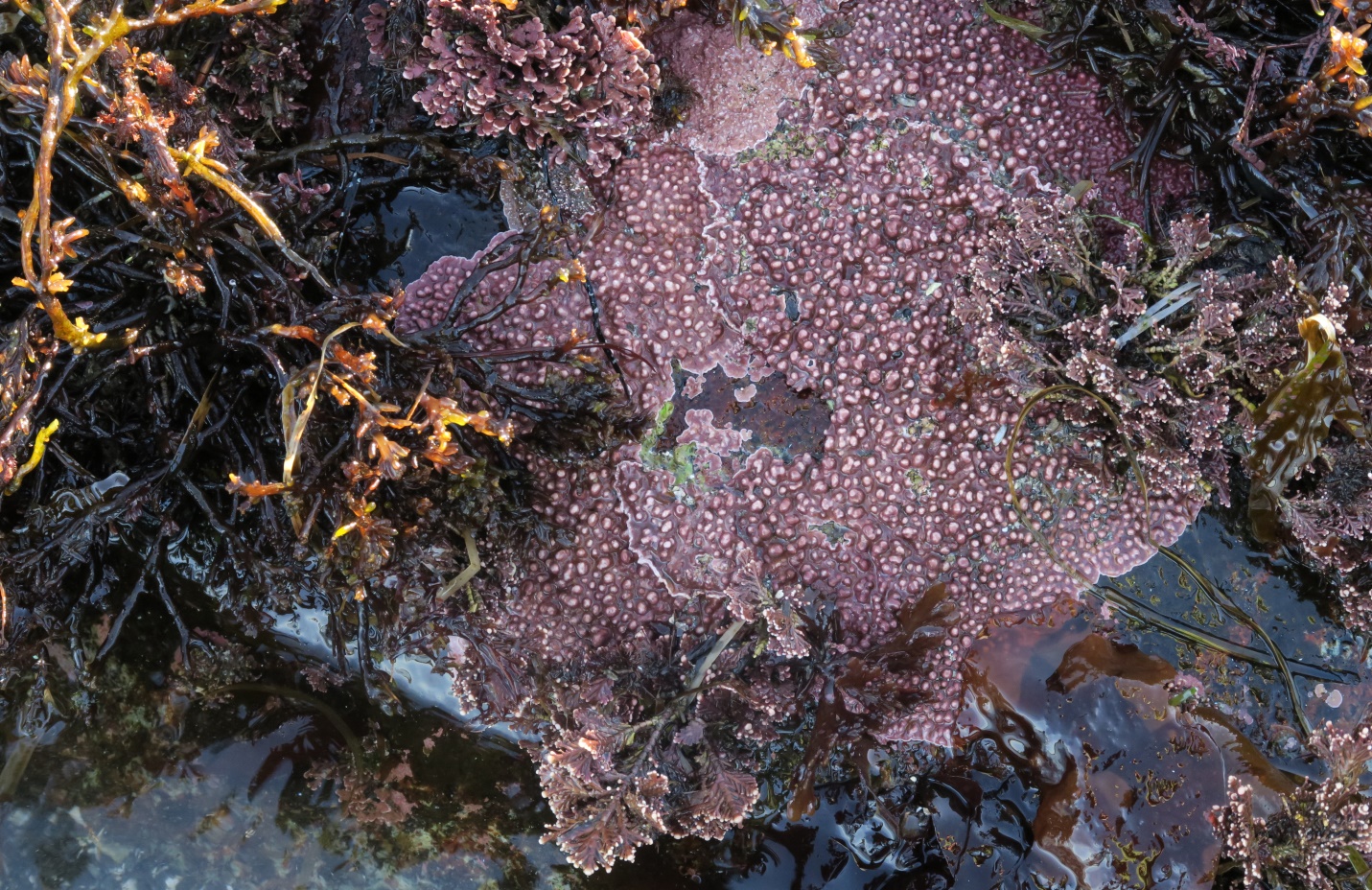
Figure 5: Competition for space is high in the rich intertidal regions. This boulder is hosting several species of fleshy seaweeds, at least two species of articulated coralline algae and also some robust patches of Boreolithothamnion phymatodeum. Big Beach, Vancouver Island, B.C., Canada. May 28, 2025. Photo ID 27796 ©Seaweedwhisperings.com
Biology & Natural History Information:
Description:
A calcified coralline crust that adheres tightly to rock. The crust is pink colored, sometimes purplish or greyish pink, usually about 1 mm thick but some specimens have been measured at up to 2 mm. The surface of this seaweed is covered in irregularly shaped but fairly regularly spaced bumps; these excrescences are hard and cannot be broken easily. Some sources use the term ‘branches’ to describe the bumps and these branches are typically up to 3 - 6 mm tall and up to 4 mm wide. As the name “litho” suggests, this seaweed grows on rock, but also grows on barnacles and mollusc shells. Growing on molluscs facilitates the dispersal of this otherwise sedentary alga.
Habitat:
On rock, stones, or mollusc shells and subtidal barnacles, or other algae in the lower intertidal to shallow subtidal (to 15 meters). Only rarely found in mid-intertidal areas.
North Pacific Distribution:
Kamchatka Is, Alaska, British Columbia, Washington, Oregon, California, Mexico and the Gulf of California; Russia, Sea of Japan.
Remarks:
This crust is a desirable food source of various limpet species. The bumpy surface of Boreolithothamnion phymatodeum is thought to be a physical deterrent to mulloscan grazers. The highly uneven surface created by the bumps makes it difficult for limpets to keep a grip, especially in high water action conditions.
Classification:
Phylum: Rhodophyta
Subphylum: Eurhodophytina
Class: Florideophyceae
Subclass: Corallinophycidae
Order: Hapalidiales
Family: Hapalidiaceae
Genus: Boreolithothamnion
Species: Boreolithothamnion phymatodeum (Foslie) P.W.Gabrielson, Maneveldt, Hughey & V.Pena 2023
Former name(s): Lithothamnion pacificum; Lithothamnion phymatodeum.
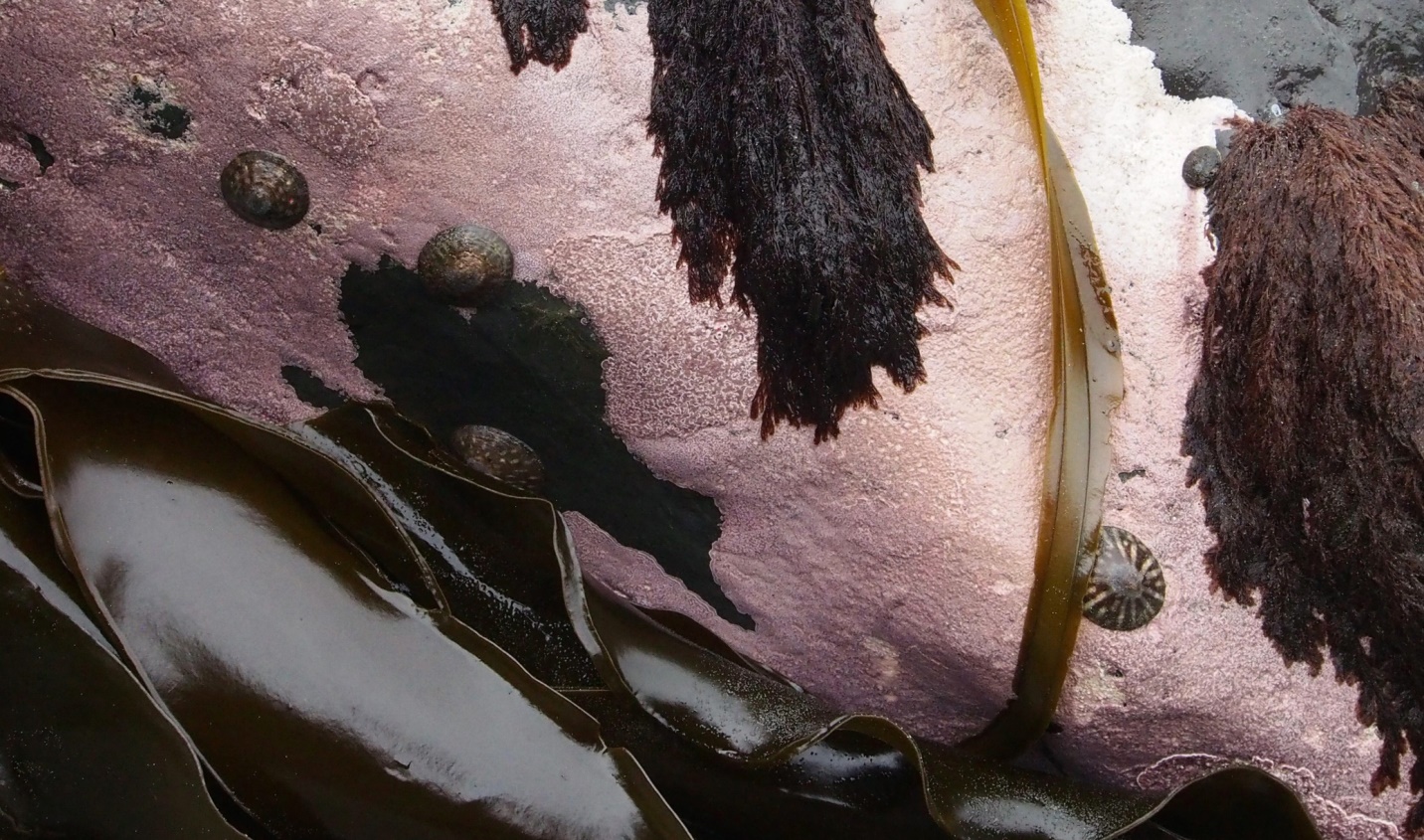
Figure 6: This large patch of coralline crust is being grazed by four limpets. B. phymatodeum is evidently a much-desired food for limpets and its characteristic bumps are thought to be a physical deterrent. Sometimes this works, sometimes not so well. Fishboat Bay, Juan de Fuca Strait, B.C., Canada. June 26, 2025. Photo ID 27797 ©Seaweedwhisperings.com
![]()